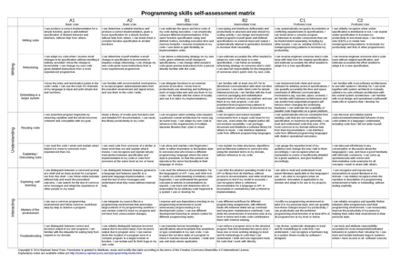| Self Assessment For Programmers |
| Written by See Gee |
| Monday, 21 July 2014 |
|
A useful proficiency matrix has been produced that could be used to track your own progress when learning to program or to advertise your skillset to prospective employers. The Programming skills self-assessment matrix is a table that has been made available under a Creative Commons Attribution-ShareAlike 4.0 International License. It was drawn up by Raphael 'kena' Poss, a researcher in the Computer Systems Architecture Group of the University of Amsterdam.
In his post, How good are you at programming?, Poss explains that the initial idea of an assessment matrix appeared during discussions about average programmer skills in online forums and that he used the structure of the CEFR (Common European Framework of Reference for Languages) relating to proficiency in foreign languages as the basis for measuring proficiency in programming languages. The matrix can be applied to any language and identifies three broad levels:
The levels are the columns of the table and each is subdivided into two with a testable milestone for each sub-level. The rows are for different programming activities in three groups:
Poss gives the following suggestions of how to use the matrix.
and suggests several scenarios in which it might be useful:
Having this type of standard seems a great idea - but of course it needs people to use it and to share it with others so that it catches on.
More InformationHow good are you at programming? Programming skills self-assessment matrix Related ArticlesIs Programming Skill Related To Age? Programming - A Life Long Challenge
To be informed about new articles on I Programmer, install the I Programmer Toolbar, subscribe to the RSS feed, follow us on, Twitter, Facebook, Google+ or Linkedin, or sign up for our weekly newsletter.
Comments
or email your comment to: comments@i-programmer.info |
| Last Updated ( Monday, 21 July 2014 ) |


